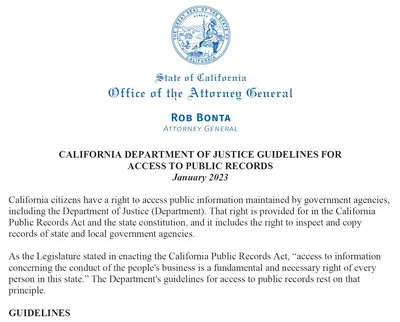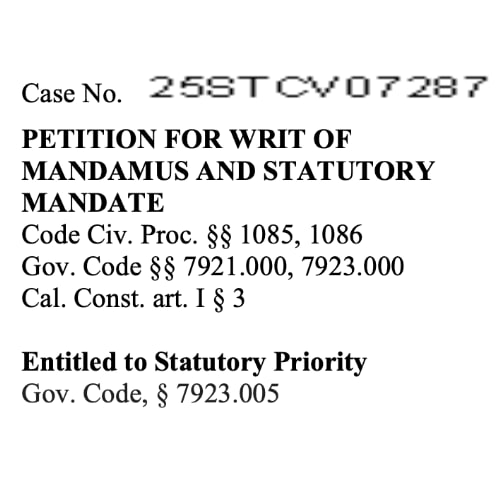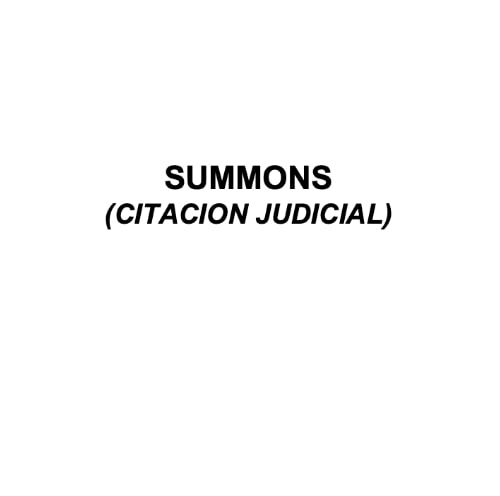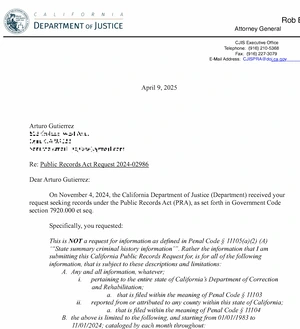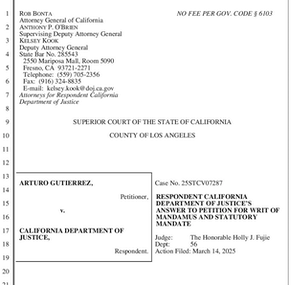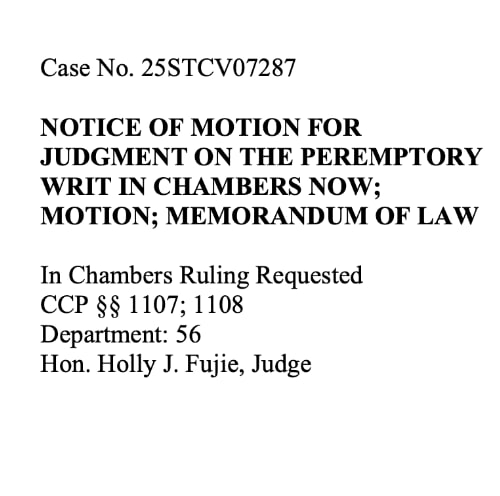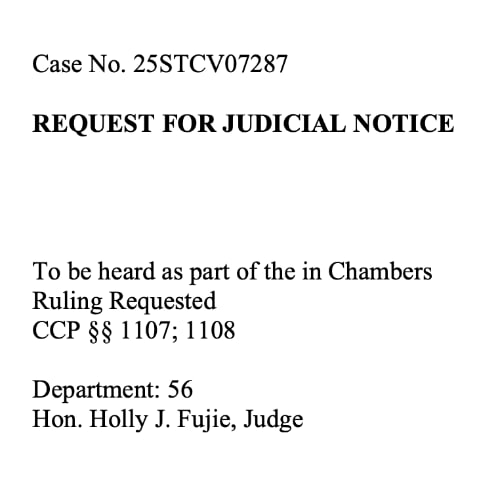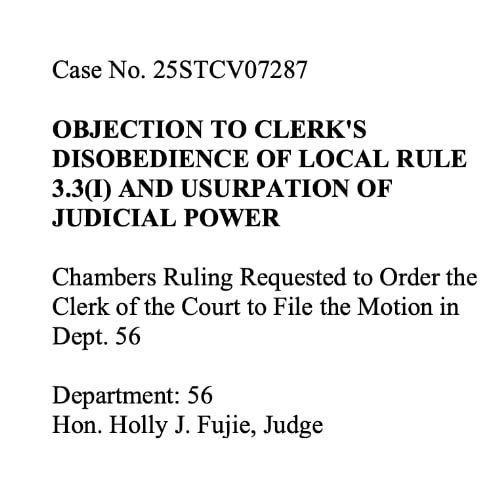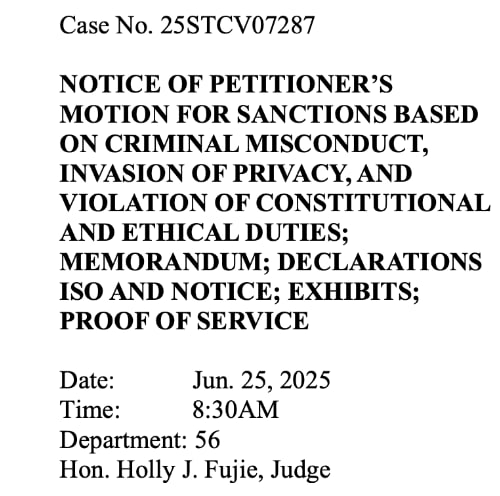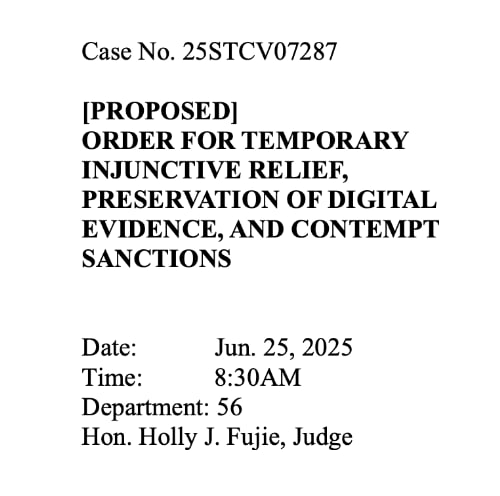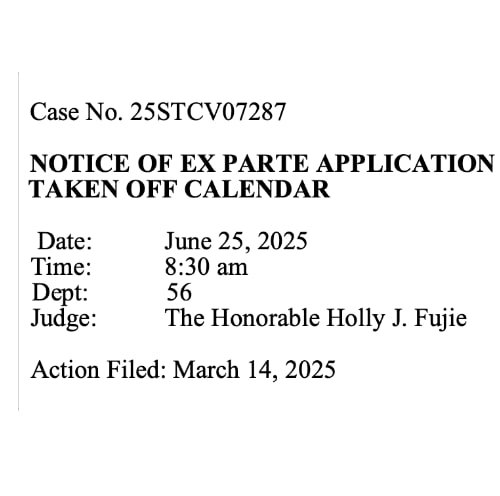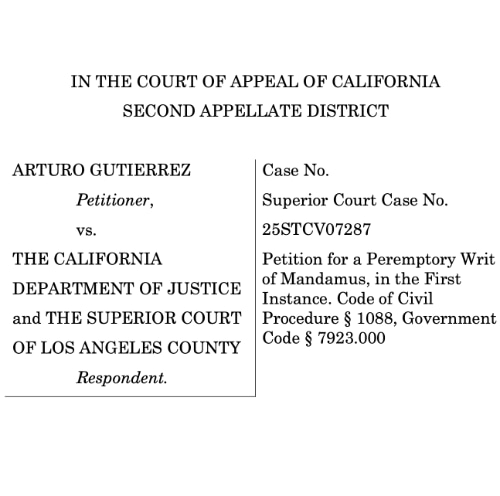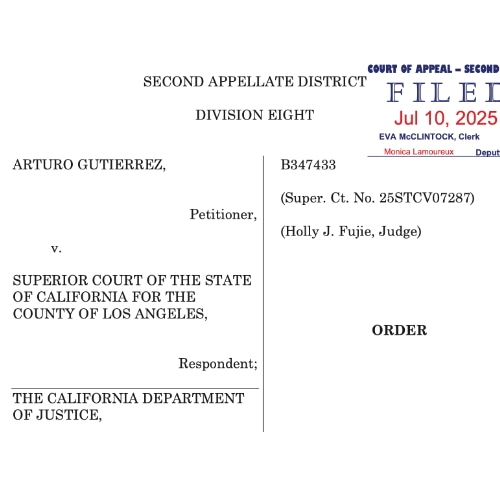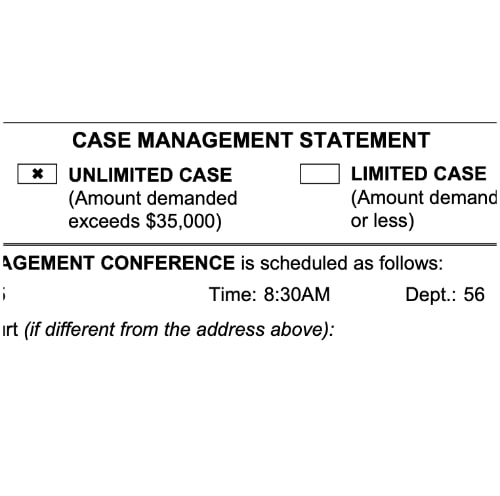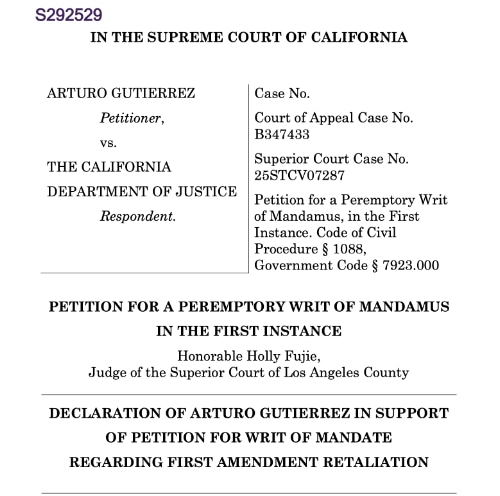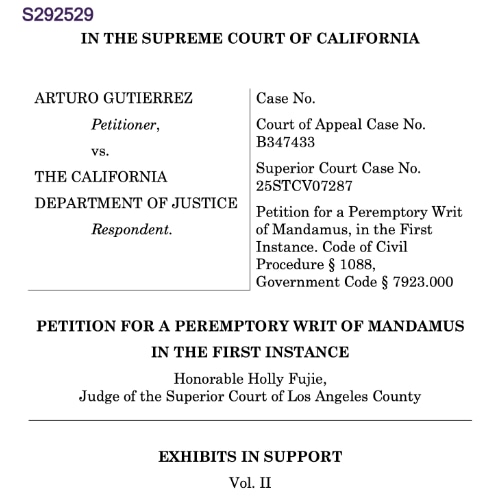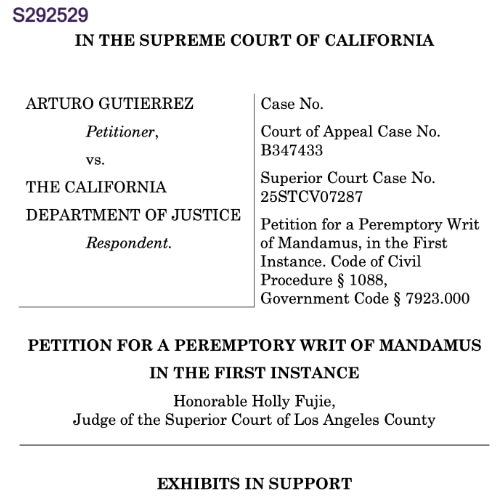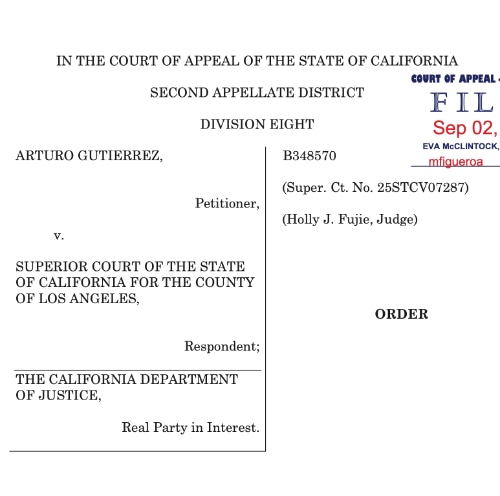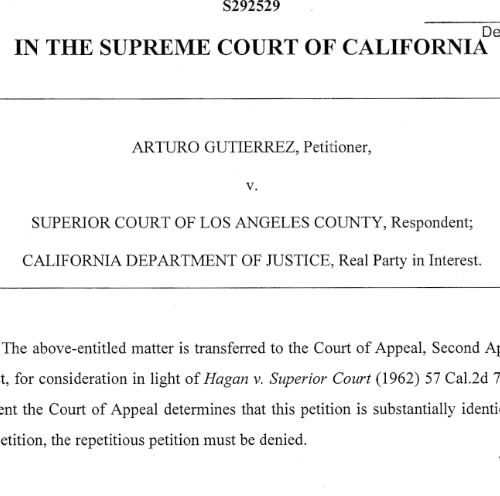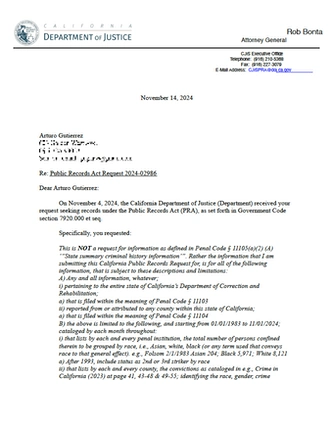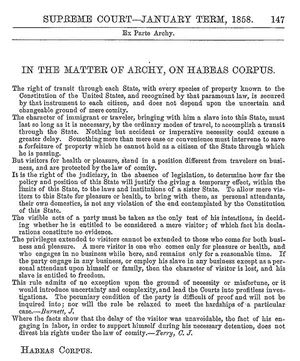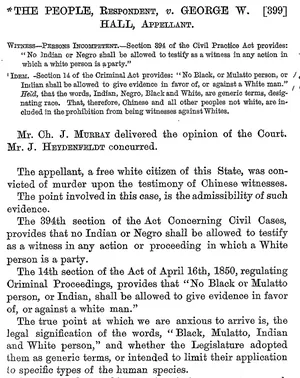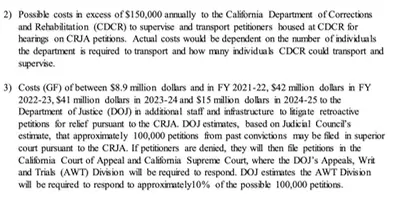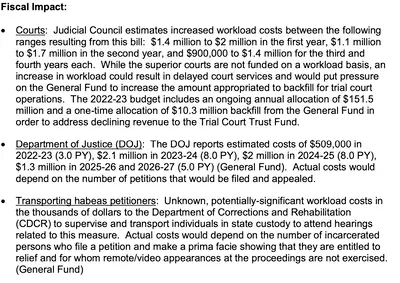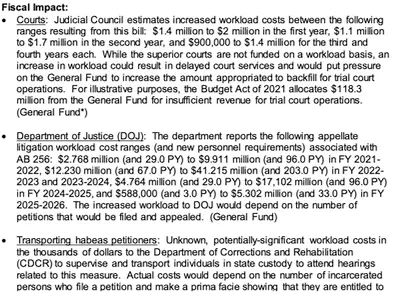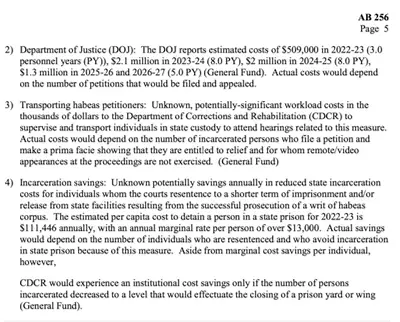Media Resources Page
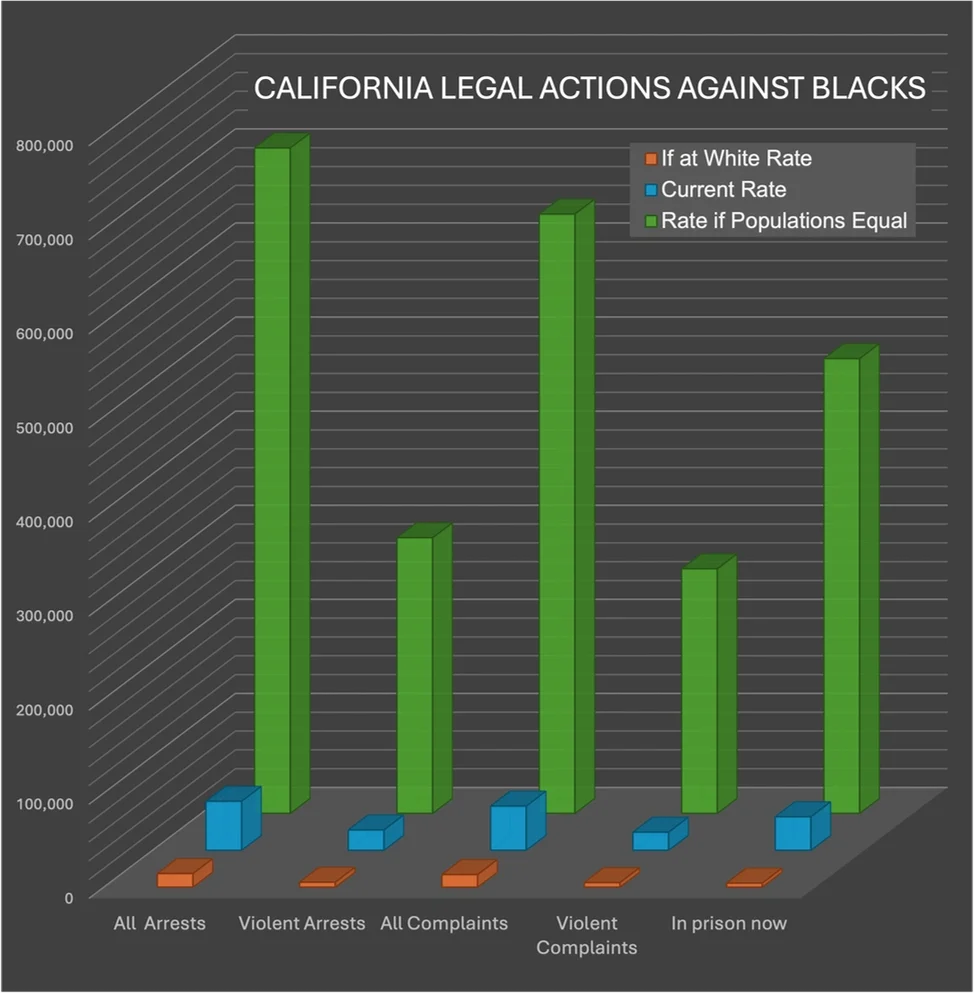
For a higher resolution image of bar graph, click here.
There is nothing the DOJ does not track, from arrest to every possible disposition. Many kinds of data points are included, especially race.
See Cal. Pen. Code §§ 11103, 11104, 13010, 13011, 13012, 13020, 13100, 13101, 13102, 13103, 13104, 13200, 13305(a), and 13370.
Racial Injustice Investigation Revealed Incidents of Slavery
Snap shot of timeline of events:
A Black male friend requested his case be looked at under the new Cal. Pen. Code § 745, (requires specific data to establish racially motivated sentence or charge).
His two white co-defendants were given 4 & 9 years; and allowed to plead to one charge. But he was the Black co-defendant, and threatened with 136-years-to-life; thus rather than die in prison, he was forced to accept 42 years and required to plead to every charge and accusation. The full backstory of events on that case can be read here.
The California Department of Justice, Open Justice portal, does not provide the required data. Despite having it all. Without it, racial justice claims were a false hope.
Finally, the mother of invention kicked in. Our math teachers always said some day we would need algebra. Because yours likely said the same, that means we can communicate.
Applying the common denominator theory seemed the only logical way to evaluate the numbers to ascertain if there was disparate treatment occurring. The bar graph shows the answer, (methodology discussed further below.)
Then I found Penal Code §§ 11103 and 11104, which not only prove that the DOJ always possessed the very data needed for Penal Code § 745 claims — but also made clear that the data was not confidential, and therefore had to be released.
So I did the logical next step: I submitted a request asking for it all.
What followed was never expected — and it explains exactly why the DOJ had kept it hidden.
That’s the story here.
The Legal Action Filed
The Particulars of the Lawsuit
Timeline of Events
- 11/4/24 – Request submitted to DOJ.
- 11/14/24 – DOJ promised compliance by 12/2/24;
- 11/14/24 – We supplied proof of ongoing incidents of slavery. DOJ ceased all communications after that.
- 12/10/24 & 1/6/25 – Follow-up emails ignored.
- 3/14/25 – Lawsuit filed in Los Angeles Superior Court.
- 4/9/25 – DOJ issued a denial letter, five months late.
- 4/11/25 – DOJ filed an unverified answer (legally invalid) denying prior silence.
- 5/19/25 – Motion for judgment filed; court failed to act.
- 6/25/25 – Hearing set to obtain a ruling; court removed from calendar.
- 7/7/25 – Court of Appeal filing; denied in 3 days while citing cases affirming our position.
- 7/27/25 – Trial court set uncontested case for October 2026.
- 8/20/25 – Petition filed in California Supreme Court.
- 8/28/25 – Chief Justice ordered the case transferred to Court of Appeal with directions to deny.
- 9/2/25 – Court of Appeal denies as ordered by Chief Justice.
- The case was not set for Supreme Court conference on 8/27 or 9/3.
- (All set out with greater detail after the filed court documents.)
Mandamus & Public Records Act Basics
Mandamus is a special proceeding—streamlined and designed to compel a public agency to follow the law. See Cal. Code Civ. Proc. §§ 1084–1097. In all other cases, a verified petition prompts the court to issue an alternative writ of mandamus, giving the agency two choices: (1) do the act required, or (2) appear and show cause for not doing it. If facts are genuinely disputed, the court may take evidence; otherwise it decides the legal issues quickly. There are no trial or appeals in these matters, specifically to prevent stall tactics and gamesmanship.
Public Records Act Framework
- Gov. Code § 7923.000 – Authorizes any person to use mandamus to compel access to public records.
- Gov. Code § 7923.100 – Requires courts, upon verified petition showing records withheld, to order disclosure or compel the officer to show cause for withholding.
- Gov. Code § 7923.110(a) – If refusal to disclose is unjustified, the court must order disclosure.
These Events Have Never Happened Before in California.
No California case addresses an agency that simply refuses to act at all. When an agency stays silent and issues no timely written decision, it cannot later justify withholding. That is why a peremptory writ—immediate compliance without further contest—was appropriate here.
The Public Records Act directs courts to proceed “the object of securing a decision as to the matters at issue at the earliest possible time.” (Gov. Code § 7923.005) Matters at issue means legally contested, and earliest possible time does not mean: Disregarding three chances to decide —the initial filing (Gov. Code § 7923.110(a)); the request for ruling after failing to file a lawful answer (Code Civ. Proc. § 1094), and when placing it on calendar for a ruling (id.). The court then set this uncontested case for trial 16 months later. That is the opposite of “earliest possible time.”
Because the lower courts were paralyzed, the matter was directly filed in the California Supreme Court as an original proceeding on Aug. 20, 2025.
Steps After Victory
As discussed just above in the § 745 section, the point of compelling DOJ is to unlock the race-crime statistical baselines that § 745 claims require. Once DOJ complies:
- We will generate county- and facility-level disparity ratios (by offense, time period, and custodial status) to establish the required prima facie baselines for § 745 petitions.
- We created a tool to auto-populate declarations and exhibits for incarcerated individuals and families so they can file correctly, without guesswork.
For a broader constitutional context, see the Thirteenth Amendment in the Constitution Annotated — the only Congress-approved annotation, codified at 2 U.S.C. § 168.
The DOJ's own Guidelines Declare their Actions are Illegal and without any Basis in Law.
Documents Filed in Court
DOJ Responds 5 Months Later
May Filings Seeking the Writ Now as Required by Law
June Filings Seeking Ruling Now, Again
June Motion for Sanctions for Spyware
June-July Filings Court of Appeal
July Superior Court Trial Setting for Oct. 2026
August Filings California Supreme Court
Back to Back Supreme and Appellate Courts
In the Petition the Hagan issue was addressed, showing that new events had occurred with legally makes it not a Hagan case, once the trial court set it for trial, when uncontested, 16 months later. The Chief Justice then added the superior court as a defendant and moved the named DOJ defendant out of the line of fire, ordering “must be denied.” Again, a new event in California law. Note the Court of Appeal stating they were ordered to dismiss, “with directions to deny the petition”. By the way, the Supreme Court only conferences on Wednesday. I am not on the conference list for Aug. 27 nor Sept. 3.
In other words, the Court of Appeal denied relief not on its own judgment, but because the Chief Justice told it to do so, despite new prejudice in the trial court.
Cal. Const. art. VI sec. 10 “The Supreme Court, courts of appeal, superior courts, and their judges have original jurisdiction in habeas corpus proceedings. Those courts also have original jurisdiction in proceedings for extraordinary relief in the nature of mandamus, certiorari, and prohibition.”
Significant because under long standing case law from the Supreme Court, a single justice does not have that power In re Eighth Street (1871) 40 Cal. 481, 482-484. Yet the Chief Justice just single-handedly ordered a lower court to dismiss after switching the parties on a concealment of incidents of slavery case.
“The Secretary of State shall submit a final copy of this formal apology to the State Archives, where it shall be available for viewing by the general public in perpetuity. The Legislature shall prepare the formal apology, which shall bear the Great Seal of the State and requests that this apology be signed by the Speaker of the Assembly, the President pro Tempore of the Senate, the Governor, and the Chief Justice of California.” (Gov. Code sec. 8301.4) (Added by Stats. 2024, Ch. 624, Sec. 1. (AB 3089) Effective January 1, 2025.)
“The State of California recognizes and accepts responsibility for all of the harms and atrocities committed by the state, its representatives thereof, and entities under its jurisdiction who promoted, facilitated, enforced, and permitted the institution of chattel slavery and the enduring legacy of ongoing badges and incidents from which the systemic structures of discrimination have come to exist.” (Gov. Code sec. 8301.2(a))
Next stop, SCOTUS.
Given the anticipated desire to investigate the facts and for the various legal departments to know they are on solid footing before green lighting any publications. To serve those dual tasks and expedite the process, facts are presented alongside law. Forgiveness is begged in advance as reports such as these are always intended to be brief but the inherent drive to be thorough always prevails.
Chronology of Events
California Constitution Article I Sec. 3
(a) The people have the right to instruct their representatives, petition government for redress of grievances, and assemble freely to consult for the common good.
(b) (1) The people have the right of access to information concerning the conduct of the people’s business, and, therefore, the meetings of public bodies and the writings of public officials and agencies shall be open to public scrutiny.
(2) A statute, court rule, or other authority, including those in effect on the effective date of this subdivision, shall be broadly construed if it furthers the people’s right of access, and narrowly construed if it limits the right of access.
California Public Records Request Act
Cal. Gov. Code sec. 7921.000 “In enacting this division, the Legislature, mindful of the right of individuals to privacy, finds and declares that access to information concerning the conduct of the people’s business is a fundamental and necessary right of every person in this state.”
A request was drafted so immensely broad that it could not be weaseled out of, then honed in, ever more narrowly to ensure the exact data needed was provided. Specifically excluding personal information, other than race and gender.
It was then submitted directly to the California Department of Justice on Nov. 4, 2024:
Record Description
I do not know the name of the desired records only the statutes that declare they exist. The description for the information requested is set out in a letter that is available via:
https://acrobat.adobe.com/id/urn:aaid:sc:US:981adb68-dd78-46d4-bee4-d27d2cddc3c1
Thank you.
The California Department of Justice responded on Nov. 14, 2024. Their response is below:
The Information did Not Yield the Response Anticipated
“For the reasons set forth below, this office is extending the date for responding to your request to December 2, 2024.” “In this instance, an extension is needed to consult with multiple components of the Department with substantial interest in the records requested.”
It was supposed that the same reaction that all have to this information would be shared by an entity that operates under a specific Constitutional command Cal. Const. art. V sec. 13 “the Attorney General shall be the chief law officer of the State. It shall be the duty of the Attorney General to see that the laws of the State are uniformly and adequately enforced.” See also, Gov. Code, § 12510 (“The Attorney General is head of the Department of Justice.”); Gov. Code, § 15000 (“There is in the State Government a Department of Justice. The department is under the direction and control of the Attorney General.”) Therefore, that same evening, a response was submitted to the Department of Justice.
Thu, Nov 14, 2024 at 7:14 PM
Yes, I completely understand the need for an extension due to the volume and breadth of the request. Thank you for your timely advisement and for your efforts regarding the matter.
After reading my original request again, it is hoped that the Department understood the reference to CDCR to include its prior iterations as well, the CA prison system in whatever names it has previously used.
Given the reply noted a need to consult with multiple interested parties, I have prepared an explanation of the request to be considered during such consultations. It promises to be one of the most interesting documents you will read. Please see attached.
What Mattered was Made Clear
The letter broke down the numbers and results shown in the above bar graph and discussed below. Setting forth the relevant laws and cases and concluded with:
It is hoped that when consulting “with multiple components of the Department with substantial interest in the records requested”, they consider the gravity and weight of 31,000 slaves that have a substantial federal interest in being subject to like punishment, and to no other. 42 U.S.C. § 1981(a)
Mr. Justice Douglas made an immensely profound point:
“The true curse of slavery is not what it did to the black man, but what it has done to the white man. For the existence of the institution produced the notion that the white man was of superior character, intelligence, and morality.” (Jones v. Mayer Co. (1968) 392 U.S. 409, 445, Douglas, J., concurring.)
The purpose of this request is to end the incidents of slavery that are in effect in California by imprisoning Blacks at a grossly disproportionate rate. “Severer punishments for crimes were imposed on the slave than on free persons guilty of the same offences.”
483,285 Blacks in prison vs. 56,659 Whites in prison right now
Yet if the rate of White incarceration was applied to the Blacks,
then the 35,532 Blacks in prison should be 4,161.
Gov. Code, § 7922.535(c)(3) (“The need for consultation, which shall be conducted with all practicable speed, with another agency having substantial interest in the determination of the request or among two or more components of the agency having substantial subject matter interest therein.”)
Tue, Dec 10, 2024 at 11:33 AM
I hope this email finds you well and enjoying the holiday season.
I am following up on our previous correspondence regarding the Department’s invocation of the 14-day extension to respond to my public records request, which extended the deadline to December 2, 2024. In my last letter, I expressed understanding for the extension given the volume of information and the complexity of the issues involved. I also provided detailed good cause supporting the urgency of the request and emphasized the importance of considering the substantial interest in the matter when evaluating the data.
The data included in my reply highlights a serious situation with significant constitutional implications. I had hoped the Department would be thoroughly assessing the matter in light of its obligations under the Office of the Attorney General. When no response was received on December 2, I refrained from following up immediately, understanding the demands on your office and the potential disruptions of the holiday season.
However, as more than a week has now passed, I wanted to ensure the matter has not been inadvertently overlooked amidst competing priorities.
Could you please provide an update on the status of my request, including the Department’s intentions regarding compliance and an anticipated timeline for response?
Also, I am including a bar graph generated to help with a visual understanding of the alarming results of the data previously provided.
Thank you for your attention to this matter, and I look forward to your reply.
Mon, Jan 6, 2025 at 11:20 AM
It is hoped this message finds you well.
The Department is now over a month past the legally permitted deadline, requiring yet another follow-up inquiry as to my public records request of November 4, 2024. To which the Department initially extended to December 2, 2024, under the Department’s invocation of the 14-day extension on November 14, 2024. Despite my previous correspondence on December 10, 2024, and the significant gravity of the issues at hand, I have received neither the requested records, nor any substantive response, not even a courtesy reply to my inquiry re status.
As you are aware, the information requested pertains to systemic racism and seeks to address deeply rooted constitutional concerns. The gravity of these issues underscores the critical importance of timely compliance. I understand the demands on your office and the potential disruptions caused by the holiday season, but the continued lack of communication is concerning as it is placing the Department in a questionable light.
I kindly ask for a clear update on the status of my request, the Department’s intentions and an anticipated timeline regarding compliance, please respond no later than January 7, 2025, by 5:00PM. A lack of response risks severely undermining public confidence in the transparency, accountability, and impartiality that the Office of the Attorney General represents. Followed by the remedy for this ministerial task, assuming this would now be the fourth time the Department has failed to comply.
It is hoped that eventuality will not be necessary as I trust this matter will now receive the attention it deserves and look forward to your prompt reply.
You are not reading this because the Department of Justice eventually complied with the law.
A Sample of Relevant Laws
Cal. Public Record Laws
Not even the express stated purpose of wanting to end slavery was a good enough reason to deny.
ARTICLE 1. Nondiscrimination Gov. Code, § 7921.300 (“This division does not allow limitations on access to a public record based upon the purpose for which the record is being requested, if the record is otherwise subject to disclosure.”) Gov. Code, § 7922.500 (“Nothing in this division shall be construed to permit an agency to delay or obstruct the inspection or copying of public records.”)
Federal Law
The public interest here is so immense, that we once engaged in a devastating civil conflict. See American Civil War 1861-1865. See also Reconstruction Era, 1866-1877 and Civil War amendments XIII, XIV, XV and the Civil Rights Act of 1866.
“The long existence of African slavery in this country gave us very distinct notions of what it was, and what were its necessary incidents. … Severer punishments for crimes were imposed on the slave than on free persons guilty of the same offences.” Violating “the essential distinction between freedom and slavery.” (Civil Rights Cases, (1883) 109 U.S. 3, 22) Which violates the absolute prohibition on slavery and incidents thereof, Griffin v. Breckenridge, (1971) 403 U.S. 88, 105.
Gov. Code § 7922.540 (a) “A response to a written request for inspection or copies of public records that includes a determination that the request is denied, in whole or in part, shall be in writing.
(b) The notification of denial shall set forth the names and titles or positions of each person responsible for the denial.
(c) An agency shall justify withholding any record by complying with Section 7922.000.”
Gov. Code, § 7922.000 (“An agency shall justify withholding any record by demonstrating that the record in question is exempt under express provisions of this division, or that on the facts of the particular case the public interest served by not disclosing the record clearly outweighs the public interest served by disclosure of the record.”)
“The Thirteenth Amendment” that “undertook to wipe out these burdens and disabilities, the necessary incidents of slavery, constituting its substance and visible form” “by the Civil Rights Bill of 1866” (Civil Rights Cases, supra.)
Civil Rights Act of 1866, ch. 31, § 1, 14 Stat. 27 (1866):
42 U.S.C. § 1981(a) (“Statement of equal rights All persons within the jurisdiction of the United States shall have the same right in every State… as is enjoyed by white citizens, and shall be subject to like punishment, pains, penalties… of every kind, and to no other.”)
Because “slavery… shall [not] exist within the United States,” (U.S. Const. amend. XIII) “the Civil War Amendments were unquestionably designed to condemn and forbid every distinction, however trifling, on account of race.” (Oregon v. Mitchell (1970) 400 U.S. 112, 127) By “preventing State Legislatures from enslaving, under any pretense, those whom the first clause declared should be free.” (Jones v. Mayer Co. (1968) 392 U.S. 409, 430, fn. 48)
Incidents of slavery is not an outdated issue, see United States v. Hougen (9th Cir. 2023) 76 F.4th 805, 820, dissenting opinion; United States v. Diggins (1st Cir. 2022) 36 F.4th 302, 308.
The DOJ Must be Justified by Acting Under Still Valid California Case Law
‘“All persons’, according to Congress, included those persons cataloged as ‘every species of property known to the Constitution of the United States, and recognized by that paramount law” (Ex parte Archy (1858) 9 Cal. 147, 163-64) Because as stated in California’s constitution “slavery” was “merely directory” (id., at 169) “where slavery exists, the right of property of the master in the slave must follow as a necessary incident” (id., at 162) regardless of “different descriptions of private property” (id.) there exists “a sincere desire to extend” “all the hospitalities consistent with our own just rights” because of “our policy and duty not to clog the privilege of visiting us, with unnecessary restrictions.” (Id., at 167)
When a case is overruled, a court notes it when citing it later. “(Cf., e.g., Ex parte Archy (1858) 9 Cal. 147, 171 [applying clarification of choice-of-law rule prospectively].)(fn.17) In light of our decision…” (Kearney v. Salomon Smith Barney, Inc. (2006) 39 Cal.4th 95, 130-31) The footnote discussed something else. Showing the California Supreme Court recently cited to it as valid authority.
“The European white man who comes here would not be shielded from the testimony of the degraded and demoralized caste… the Negro… would be admitted… to testify against white citizens in our courts of law” (People v. Hall, (1854) 4 Cal. 399, 402-403) “which could only be secured by removing him above the corrupting influences of degraded castes” (id., at 403) “and turning loose upon the community the more degraded tribes of the same species, who have nothing in common with us, in language, country or laws.” (Id.) “The word ‘white’ has a distinct signification, which ex vi termini, excludes black, yellow, and all other colors. It will be observed, by reference to the first section of the second Article of the Constitution of this State, that none but white males can become electors… On examination of the constitutional debates, it will be found… to exclude all inferior races.” (Id. at 404) “This is not a speculation which exists in the excited and over-heated imagination of the patriot and statesman, but it is an actual and present danger. The anomalous spectacle of a distinct people, living in our community…” (id.)
“People v. Hall, 4 Cal. 399, 404-05 (1854) (excluding the testimony of witnesses of color on the basis of race).” (Henderson v. Thompson, (Wash. 2022) 518 P.3d 1011, 1021 n.4) That is a very good opinion breaking down what Blacks are actually facing in today’s modern world. But see Thompson v. Henderson, (2023) 143 S. Ct. 2412, Justices Thomas and Alito concurring in denial of petition for certiorari, but not for the reasons one would think.
Math and Methodology
Arrest Rate of Blacks
The common denominator method applied to the numbers, as shown to the DOJ:
Scaling the Black population (2,237,044) up to equal the White population (30,426,953) in 2020 (US Census, California) shows what the number of Black arrests would look like if Blacks were arrested at their current rate but had the same population size as Whites. (Hispanics are mostly comprised of the White race, see history and laws.) (Crime data source https://openjustice.doj.ca.gov/exploration/crime-statistics/arrests)
– 2020 Black Population: 2,237,044
– 2020 Black All Felony Arrests: 52,000
– 2020 Black Violent Arrests: 21,537
– Population Multiplier: 30,426,953 / 2,237,044 ≈ 13.6
Using this multiplier:
52,000 × 13.6 ≈ 707,200
21,537 × 13.6 ≈ 292,903
If the population size were not separate but equal then 707,200 Black felony arrests would be expected with 292,903 claimed as Black violent felony arrests, compared to the actual 194,081 all felony arrests for Whites with their 70,064 violent felony arrests in 2020.
Compare: 707,200 vs. 194,081 292,903 vs. 70,064
Same logic and method as above but using the complaints sought data in 2020:
All felony complaints 46,834 × 13.6 ≈
636,942 (Blacks) vs. 180,409 (Whites)
Violent felony complaints 19,109 × 13.6 ≈
259,882 (Blacks) vs. 64,142 (Whites)
Applying the White Privilege Rate
Alternatively, we can use the White arrest rate as a common denominator and apply it to the actual Black population, to see what the number of Black arrests would be if both groups were arrested at the same rate.
White arrest rate: 194,081 / 30,426,953 ≈ 0.00638 (or .64%)
Expected Black arrests at White rate: 2,237,044 × 0.00638 ≈ 14,272
If Blacks were arrested at the same rate as Whites, we would expect only about 14,272 Black arrests rather than the actual 52,000 in 2020.
White Violent Charges Rate: 64,142 / 30,426,953 ≈ 0.0021 (or .21%)
Expected Black Violent Charges Rate: 2,237,044 x 0.0021 ≈ 4,716
If Blacks were charged at the same rate as Whites for violent crimes, we would expect only about 4,716 Black violent complaints filed rather than the actual 19,109 in 2020.
Blacks in Prison
Critical to this equation is the actual present number of Blacks in prison, which the DOJ knows and which they are feloniously withholding.
“Racial Composition of Strikers. African Americans make up the largest group of second and third strikers (37 percent), followed by Hispanics (33 percent), and whites (26 percent). This racial composition is similar to that in the total prison population. However, African Americans make up 45 percent of the third striker population, which is 15 percent higher than in the total prison population.” A Primer: Three Strikes – The Impact After More Than a Decade, Legislative Analysist’s Office (Oct. 2005)
The Jan. 2024 CDCR Population Projection report showed a population of 96,033 humans, 92,271 men and 3,762 women.
I am truncating my research here, but the rates have remained consistent over the decades.
Therefore, of the 96,033 prisoners, if 37% are Black then they number 35,532 and because Hispanics and Whites are the same race, then 59% reveal that their number is 56,659, with the difference accounting for Asians and Other.
We apply our population equalizer multiplier of 13.6 to reveal the current incarceration rate of Blacks, if the populations were equal and the rate of imprisonment remained constant.
For the 56,659 Whites in prison right now,
there would have to be 483,285 Blacks in prison. Compare actual 35,532
Yet if the rate of White incarceration was applied to the Blacks,
then the 35,532 Blacks in prison should be 4,161.
Thus, there are approximately 31,371 slaves due their emancipation.
Nationally, for the 634,200 Whites in prison right now,
there would have to be 2,161,725 Blacks in prison. Compare actual 389,500
National population (Population of Whites/ Population of Blacks=5.55)
National Incidents of Slavery = 40% of California
Before the nation chastises California, the mirror reflects nationally:
For the 389,500 Black people in prison today, the true number would be 2,161,725 if populations were equal.
But applying the White rate, it should only be 114,240.
As the Supreme Court has long since recognized:
“The long existence of African slavery in this country gave us very distinct notions of what it was, and what were its necessary incidents. … Severer punishments for crimes were imposed on the slave than on free persons guilty of the same offences.” (Civil Rights Cases, supra.)
California accounts for about 35,000 of these cases — roughly 9% of the national total.
% all | US Population | US Arrests | % of group | US Inmates | % of group | |
All | 331,449,281 | 6,816,975 | 2.1% | 1,430,200 | 0.43% | |
White | 75.5% | 250,244,207 | 4,729,290 | 1.89% | 634,200 | 0.25% |
Black | 13.6% | 45,077,102 | 1,815,144 | 4% | 389,500 | 0.86% |
Factor+ | 5.55w | 5.55w | 2.61w | 2.11b | 1.63w | 3.5b |
2020 Census & 2019 FBI Stats
U.S. Department of Justice, Prisoners in 2020, p.13 imprisonment per 100,000 by demographic:
Year Total Fed St. Male. Fem. W B H American Indian[1] Asian
2012 627 81 545 1,202 82 296 1,866 939 1,277 132
2017 570 66 504 1,085 81 272 1,543 837 1,183 118
2018 556 64 491 1,056 80 268 1,488 804 1,165 116
2019 539 62 477 1,024 77 263 1,436 763 1,175 111
[1] Meaning native Americans, not a distinct culture from Asia specifically from India.
Visualize that Data
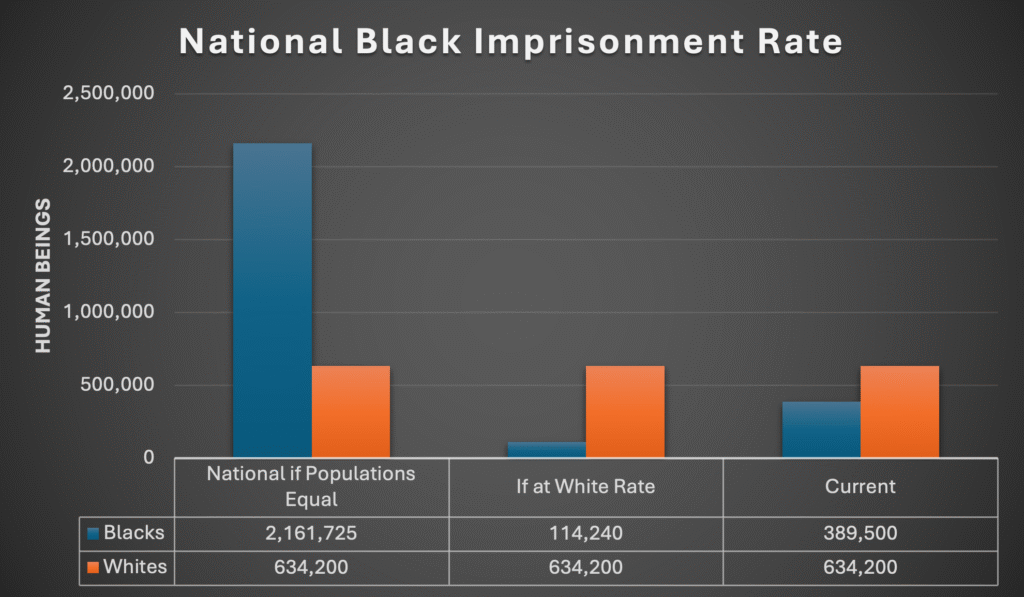
These numbers need national attention. We are living with slavery, today.
Proof that Blacks are not More Violent, Government Just Makes it Appear so
California snapshot summary of violent crimes complaints respectively by percent of that year; (to verify the numbers go to Open Justice and under Type of Arrest Disposition, choose Adult Complaint Sought; under Ethnicities, run it by each below, separately):
1995 2004 2013 2022
Blacks: 21.5% — 20.6% — 21.8% — 22.1% Average 21.5%
Whites: 34.7% — 32.1% — 31.5% — 26.4% Average 31.2%
Hispanics: 38.5% — 41.1% — 40.5% — 44.3% Average 41.1%
(race/all=%)
Blacks, as 5.56% of the state population, are 21.5% of the state’s violent crime complaints, yet comprise 37% of the second and third strike population and 45% of the third strike population. Meanwhile, as to filed complaints, 10 points higher is the whites, and nearly double is the other whites.
Complaints Sought: Custody as 2nd & 3rd Strikers Factor Difference
B Average 21.5% 37% increased +72.09%
W Average 31.2% 26% decreased – 16.67%
H Average 41.1% 33% decreased – 19.78%
The formula is: Percentage Change = { New Value − Old Value }× 100
Old Value
The average of the above decreasing percentages is 18.23%. The above shows that not only will Blacks be charged up by prosecutors, but then they will also charge down or reduce charges for the whites on average about 18% of the time. Thus 1 in 5 should get let off or the charges reduced enough to no longer be considered violent. Whereas with the Blacks, the ratio is not that one Black will not be charged or reduced down from a violent crime. Rather with the Blacks, not only will every single one not receive any dismissal or benefit, but they will drag a non-violent Black defendant in and label him or her violent to meet that 2 out of 5 consistent ratio.
Summary of Math Values
At the very top, under the bar graph, were a list of statutes that show every detail is known by the DOJ. The statutes that led to the request, also commanded that a convenient method of comparison be made. Rather than having to use comparative numbers to give a close proximation, it is our right to know the true numbers and ratios. That the DOJ committed felonies to deny those records is an overwhelming consciousness of guilt. They have known California’s involvement in the incidents of slavery and are keeping it under wraps.
The DOJ’s conduct contradicts California’s recent formal apology, effective on 1/1/2025. “Apology Act for the Perpetration of Gross Human Rights Violations and Crimes Against Humanity, with special consideration for African Slaves and their Descendants” Gov. Code sec. 8301, with its findings and promises to do better. And see ARTICLE 2. Recognition and Acceptance of Responsibility for Harms and Atrocities Committed: Formal Apology
What is also contradictory, is that not only did California just have a Black-Asian woman as Attorney General who then took on a national role as Vice-President and said nothing, but also Jerry Brown before her. A man that became Mayor of Oakland to improve the lives of Blacks. There are two conclusions to draw: a Black woman and a man that fought to protect Blacks did not care; or they did not know.
The DOJ at First was Panicked, then Realized it Controlled the Data
“Department of Justice (DOJ): The department reports the following appellate litigation workload cost ranges (and new personnel requirements) associated with AB 256: $2.768 million (and 29.0 PY) to $9.911 million (and 96.0 PY) in FY 2021-2022, $12.230 million (and 67.0 PY) to $41.215 million (and 203.0 PY) in FY 2022-2023 and 2023-2024, $4.764 million (and 29.0 PY) to $17,102 million (and 96.0 PY) in FY 2024-2025, and $588,000 (and 3.0 PY) to $5.302 million (and 33.0 PY) in FY 2025-2026. The increased workload to DOJ would depend on the number of petitions that would be filed and appealed. (General Fund)”
Senate Committee On Appropriations, Report 5/24/21 (AB 256) Chair Portantino, p.1
Because the DOJ holds the data and was aware of the truth long before they were discovered, their initial estimates to fight and keep the Blacks enslaved were:
2021-2022 $2.8m to $9.9m and 29 personnel years to fight them.
2022-2024 $12.2m to $41.2m and 67 personnel years to fight them.
2024-2025 $4.8 to $17.1m and 29 personnel years to fight them.
2025-2026 $0.6m to $5m and 33 personnel years to fight them.
However, once AB 2418 confirmed the DOJ as the sole data repository and publisher, (see Penal Code sec. 13370(a)(3) set out below) their projections radically softened:
“Department of Justice (DOJ): The DOJ reports estimated costs of $509,000 in 2022-23 (3.0 personnel years (PY)), $2.1 million in 2023-24 (8.0 PY), $2 million in 2024-25 (8.0 PY), $1.3 million in 2025-26 and 2026-27 (5.0 PY) (General Fund). Actual costs would depend on the number of petitions that would be filed and appealed.”
Concurrence In Senate Amendments, As Amended (8/24/22) (AB 256) p.5[1]
2022-2023 $0.5m and 3 personnel years to fight them.
2023-2024 $2.1m and 8 personnel years to fight them.
2024-2025 $2m and 8 personnel years to fight them.
2025-2027 $1.3m and 5 personnel years to fight them.
[1] Same numbers reported in Senate Committee On Appropriations, Report-Addendum, Chair Portantino (8/11/22) (AB 256), p.1
AB 2418 created the Justice Data Accountability and Transparency Act
This statute was unknown when making the demand. But is inline with the records sought and illegally refused:
Pen. Code sec. 13370(a) (1) It is the intent of the Legislature to create a workable system of criminal justice data transparency whereby law enforcement prosecution agencies will gather complete, accurate, and timely data in a uniform format, and make that data available to the public in a modern, open, electronic format that is machine-readable and readily accessible through an application program interface. In order that meaningful discussions can occur regarding criminal justice and its most challenging issues, including those regarding criminal caseloads, plea bargaining, race, mass incarceration, equity, and homelessness, the Legislature finds that it is an important state interest to implement a data collection, aggregation, and publishing process for criminal prosecutions to promote criminal justice data transparency. This data would be comprised of publishable statistics and other data from statewide prosecution offices. This section shall be referred to as the Justice Data Accountability and Transparency Act, “the Act,” or “JDATA.”
(2) It is the intent of the Legislature to create a reliable and robust methodology that is consistent county-to-county so that statewide data and trends may be accurately tracked. Further, the legislation shall set low technological and resource barriers so that every affected office may meaningfully participate to the fullest intent of this article.
(3) The expediency and accuracy of the data is best served by the Department of Justice as a single data aggregator and repository unit. The participation of the department as the final point of collection, aggregation, and publishing of this data is more efficient, will ensure the uniformity and accuracy of the data, and, by providing the technological resources and aggregation and publication of all data, will allow offices that lack adequate technology or resources to comply with the mandate. As used in this paragraph, technological resources means providing the basic systems and support necessary to receive the case data described in this article in standard formats from prosecution agencies statewide and aggregate that data using appropriate means developed by the department, and then publish the data in a format that will allow users to easily navigate and access the data they require, for example, on an internet website.
That statute is incredibly long and detailed.
Why would anyone need to conceal that which they were appointed the sole repository of and mandated to publish?
The answer was located:
The Slavery Apology Task Force Noted What was Important
“Data Collection The starting point is data. … Recognizing the centrality of data, the Legislature enacted Assembly Bill No. 2418 (AB 2418), the Justice Data Accountability and Transparency Act, mandating that agencies collect and transmit specified data, including data on the race of accused persons and victims, to the Department of Justice. However, AB 2418 included a funding contingency, and the law has not been funded to date.” Ch. 28, p.755
More accurately, since 1983, the DOJ has been cataloging racial statistics and refused to release them when required by the Public Records Act.
If any additional information is needed about racist treatment of Blacks, one can simply email their questions to: ReparationsTaskForce@doj.ca.gov
The entity in charge of investigating historical racism and slavery regarding Blacks in California, was the author of the California Reparations Report, and is also the entity that is covering up the continued known incidents of slavery.
The claim was lack of funding to implement, yet they were already compiling all of the data needed per Penal Code sec. 11104. If that was a genuine excuse, then why commit a felony when independently asked for that very data through a parallel means?
See Gov. Code, § 6200, and see also federal law 18 U.S.C. § 242
The Judicial Council Stats Verify the Result of the Concealment
Staff Comments: Based on the phases in AB 256 to petition the court for cases that were final before 2021, the current prison population, court statistical information, and petition trends related to Propositions 47 (2014) and 64 (2016), Judicial Council estimates the following number of habeas petitions filed as a result of this measure: approximately 5,000 in the first year, 4,000 in the second year, and 3,000 in the third and fourth years each. Feedback from the courts for AB 2542 (the precursor to this bill) indicates a general estimate of between three minutes and 15 minutes would be spent to review each petition to determine if it meets the “prima facie” standard for an additional review hearings. For 5,000 petitions that would equal roughly $251,000 to $1.255 million. Based on that same feedback, it is estimated that it takes between 30 minutes and 90 minutes for the additional review hearing for each petition that makes a prima facie showing that a violation of the CRJA occurred. It is unknown how many petitions would make a prima facie showing.
Senate Committee On Appropriations, Report 5/24/21 (AB 256) Chair Portantino, pp.4-5
Below is a combination of the Judicial Council tracking of habeas filings in criminal cases from 1994[1] to 2024. The center line is the 6,000 marker. Habeas filings were predicted to independently increase by 5,000 in 2021; 4,000 in 2022; 3,000 in 2023 & 2024.
The truth is that habeas filings dropped 2,000 in 2022; dropped 1,500 in 2023 & 500 in 2024.
[1] There was no chart for the decade ’94-‘04 in the Judicial Council report, the numbers reported were used to create a new chart.

The Bigger Picture
A Systemic Reckoning
The Media’s role in this process is critical. Drawing attention to the issues is the start of the debate process. Some of you will understand and be just as appalled as we were. Some of you will not be. And that is the essence of the point. To have a debate we must have two sides. Dissent is the essence of American freedom.
This lawsuit is not just about compelling the DOJ to release public records—it is about exposing a fundamental betrayal of justice. The California Department of Justice was entrusted with enforcing racial justice reforms, yet it has deliberately concealed the very data needed to implement them. This case reveals something far more dangerous than racial disparities in sentencing—it proves that even when laws are passed to correct injustice, they mean nothing if the agencies responsible for enforcement refuse to comply.
The implications go far beyond California. If an executive agency can openly defy the law without consequence, what does that say about the power of the legislative branch to effect real change? If the DOJ is willing to ignore the racial justice laws it was tasked with enforcing, what else is it willing to ignore? This case forces a long-overdue public debate about the unchecked power of government agencies, the failure of existing legislative reforms, and the urgent need for systemic accountability. If transparency cannot be enforced, then reform is an illusion, and mass incarceration will remain the default mechanism of racial and political control. Beyond reporting this lawsuit, the press has a duty—as the fourth branch of our checks and balances system—to ask the larger question: If the DOJ covered this up, what else are they hiding?
The true largest question: Why have we accepted a status quo where we shrug that reality off?
Justice Without a Plan Is Just a Revolving Door
If the truth is exposed and California is forced to acknowledge its use of incarceration as a tool of racial oppression, the natural next question is: What comes next? If tomorrow, 31,000 people were released from prison—men and women who have been caged for decades, stripped of opportunities, and disconnected from society—what would happen to them? Without a plan for reintegration, they would be funneled right back into the same cycle of poverty, criminalization, and re-incarceration.
California spends an average of $130,000 per year to incarcerate one person. If true justice is the goal, then why aren’t those resources being used to help people succeed rather than ensuring their failure? Real reform requires more than release—it requires a complete shift in how we treat those we have wrongfully imprisoned. That conversation must begin now, alongside the exposure of the DOJ’s misconduct. Because justice isn’t just about opening the prison gates—it’s about ensuring that no one is herded back into them.
- For this Court recognized long ago that, whatever else they may have encompassed, the badges and incidents of slavery—its “burdens and disabilities”—included restraints upon “those fundamental rights which are the essence of civil freedom, namely, the same right . . . to inherit, purchase, lease, sell and convey property, as is enjoyed by white citizens.” Civil Rights Cases, 109 U. S. 3, 22. Just as the Black Codes, enacted after the Civil War to restrict the free exercise of those rights, were substitutes for the slave system, so the exclusion of Negroes from white communities became a substitute for the Black Codes. And when racial discrimination herds men into ghettos and makes their ability to buy property turn on the color of their skin, then it too is a relic of slavery.
Jones v. Mayer Co., (1968) 392 U.S. 409, 441-443
Who is to Blame
Imagine a life where you are met with negative looks everywhere you go, people shift uncomfortably simply because you are near, you are presumed to be a threat simply because you are present, you are harassed regularly by authority, held up to a second standard in the work place, made to achieve more just to receive less, and worst of all: the law will not protect you but is extended to apply to you specifically. On top of that, there is nothing in this great country offered to you to give you a chance. And all because of the amount of melanin in your skin, not the contents of your character or the knowledge in your brain. After a lifetime of being treated as not a member of society, how likely would you be to be compelled to follow that society’s rules?
Special treatment would not be necessary if we simply provided equal treatment.
The Civil War amendments gave all of us White people the protections of the Fourteenth Amendment, freedom of press, right to self-defense, prohibiting warrantless searches of our home, privilege against self incrimination, right to jury trial, counsel, free of cruel and unusual punishment, freedom from fabricated charges and false evidence, right to proof beyond a reasonable doubt and on and on, all given to us because of the Civil War amendments enacted to protect Blacks. Which we all enjoy the fruits of, because “nor shall any State deprive any person of life, liberty, or property, without due process of law; nor deny to any person within its jurisdiction the equal protection of the laws.”
Can we say we have ensured that shall apply to all of us equally?
Or have we been complicit in allowing it to occur by not extending our voice to protect them?
The very purpose of the jury trial is that only the people can decide when another shall surrender liberty. No judge, prosecutor or cop has that power. It is reserved exclusively to the individual and the community, sitting as the jury. Our voice speaks in the courtroom. Our failed voice outside of it has allowed for current events to manifest.
Our entire system was set up so that we are the ultimate protectors of each other.
Again, with apologies for the length of the information provided. But as this is an important issue, the full scope of information was necessary to present, allowing your skills to present the core information to the masses.
About the Author
Arturo Gutierrez was raised in Southern California, son of an outspoken mother and a Superior Court judge, the role of the advocate was the natural path.
Possessing a very high IQ and near perfect auditory memory, tests were taken that declared sufficient knowledge was possessed to earn an AA equivalency degree. In short, college was skipped. Traveling the world as a source of education. Then law school, graduating with honors in 2004.
During the budget crisis of 2004-2005, a career in the law commenced as a prosecutor, working without pay for nearly two years. Then became married and worked for a Worker’s Compensation defense firm then switching sides and running an Applicant’s firm.
When his father retired in 2008, the two began their life dream of running a criminal defense law firm together. Life was good.
However, Arturo Gutierrez was assassinated on 12/1/2012. Criminals wearing badges became aware of recommended legal actions for their felonious treatment of a young woman. Fearing exposure, they simply committed a massive amount of perjury and declared (while he was advising an underage girl that she should take legal action against police investigating her life), that this was deemed the ideal time to engage in sexual relations with her. Of course the additional volume of lies told to the media were too tempting to not report. Thus, it was covered nationally for one day and ran during every news cycle in California for 3 days.
After proving the warrants and police reports contained over 130 lies and concealment of exculpatory evidence, to which the Orange County Prosecutor did not refute, the trial court nevertheless denied the constitutional right to a hearing and denied the motion to dismiss.
The only means to protect and defend at trial would be to reveal attorney client privilege. Just like any true reporter would never give up their sources; so too would any true attorney, beholden to their oath, violate privilege. See Business and Professions Code sec. 6068 “It is the duty of an attorney to do all of the following: (e) (1) To maintain inviolate the confidence, and at every peril to himself or herself to preserve the secrets, of his or her client.”
Threatened with years in prison if fought and lost, the ability to defend denied by professional obligation, then offered the chance to appeal what was obligatory to overturn and take six months of house arrest, the offer was accepted. To honor the oath, it was necessary to allow it to execute its holder.
It was then discovered that out of 9,000 pages of information from Facebook, all organized chronologically, that one person’s communications were placed out of chronological order. What should have been in the #4 place, was placed in #1. That person was a different person than the claimed victim. This second person was a pregnant woman that had been beaten and strangled and upon calling police, they denied her demand for citizen’s arrest and threatened to arrest her; Gutierrez filed an internal affairs’ complaint on her behalf, just four months prior to the arrest. (Eight years later when finally obtaining all property back, it was discovered that they had wiped the hard drives of all the computers; California law declares they were to have no access, now none could be proven.)
Through stitching together various laws, a means to communicate the attorney-client privilege under seal was patched together and a petition for habeas corpus was filed establishing that the Attorney General lied to the Court of Appeal about a crucial aspect, the illegal effort to retaliate for advocacy, and to gain access to attorney-client privilege, because “materials protected by the attorney-client privilege are not subject to disclosure pursuant to a search warrant.” (People v. Superior Court (Laff) (2001) 25 Cal. 4th 703, 716)
The Court of Appeal threatened to dismiss the habeas petition if it was not filed un-sealed, which would reveal the privilege. Despite being then suspended, the rule says every peril, meaning all of them. Their offer was declined in writing.
Simultaneously, the State Bar was moving for summary disbarment, despite being alerted to the breach and asked for help. They eventually succeeded, and disbarment ordered. The Court of Appeal was notified of the change of events. In turn, they immediately ordered the petition be filed un-sealed. Without a legal basis to defy their order, it was complied with. A month later, they wrote back: “The petition for a writ of habeas corpus is DENIED.”
Then after that, a 130-page petition for habeas corpus, including over 1,500 pages of supporting exhibits, was filed with the California Supreme Court. They held on to it for 8 months until one week after probation ended. When denying it, the stated basis was that it was a requirement of habeas to provide supporting documents.
Waiting till after probation ended precluded habeas corpus from being submitted to the federal courts. A month later was March of 2020, some of you might remember that time. The U.S. Supreme Court altered its rules, providing just enough to allow a petition to be filed. But at that time, it was not fully understood how to present issues to get their attention. Denied.
The justice system was easily manipulated to destroy the life of a criminal defense attorney. The truth was ignored once exposed. If a person with specialized training cannot protect himself from government corruption, then what chance do you have?
After my arrest, Edward Snowden stood up for all of us and was crucified. Then a number of people started saying ‘well I do not care if they read my email, I have done nothing wrong.’ So Bill Maher brought on the former director of the NSA to discuss it. And the director said, “It’s not about whether you have committed a crime or not. It’s about whether the government DECIDES to think you have committed a crime.” That is exactly the point and is the actual true issue here: unchecked power.
One man committing volumes of perjury to retaliate for protecting women resulted in the loss of ability to earn a living and enjoy life, which causes another sort of relation to the above issue.
As stated in Yick Wo v. Hopkins, (1886) 118 U.S. 356, 370: “For, the very idea that one man may be compelled to hold his life, or the means of living, or any material right essential to the enjoyment of life, at the mere will of another, seems to be intolerable in any country where freedom prevails, as being the essence of slavery itself.”
12 years a slave gained an acute understanding of the issue. The man that was discussed at the outset was met along this path. Fate would seem to have had a design that would then cause the revelation of what is occurring in California.
This present issue is not about your author, but these events are disclosed for if not it could be then used as a means to distract, as those immensely more powerful have a secret to keep.
I have done and will do my part, your protection is needed to allow it to be completed.
A maxim of law provides, “A person who has fraudulently dispossessed themselves of a thing may be treated as if they still had possession.” (Civ. Code sec. 3518) Therefore, this leads to one other obligation imposed upon attorneys under Bus. & Prof. Code sec. 6068(h) “Never to reject, for any consideration personal to himself or herself, the cause of the defenseless or the oppressed.”
Thus, a dozen years spent studying all the means and ways to survive injustice was decided to be given away to those that need it, yet lack the skill sets to find it.

